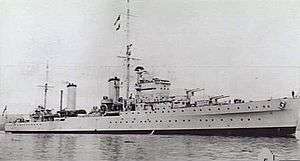HMS Galatea (71)
 HMS Galatea as completed, circa. 1935 | |
| History | |
|---|---|
| Name: | HMS Galatea |
| Builder: | Scotts Shipbuilding and Engineering Company (Greenock, Scotland) |
| Laid down: | 2 June 1933 |
| Launched: | 9 August 1934 |
| Commissioned: | 14 August 1935 |
| Identification: | Pennant number: 71 |
| Fate: | Sunk by German submarine U-557, off Alexandria on 14 December 1941 |
| General characteristics | |
| Class and type: | Arethusa-class light cruiser |
| Displacement: |
|
| Length: | 506 ft (154 m) |
| Beam: | 51 ft (16 m) |
| Draught: | 14 ft (4.3 m) |
| Propulsion: |
|
| Speed: | 32 knots (59 km/h) |
| Range: | Unknown; 1,325 tons fuel oil |
| Complement: | 500 |
| Armament: |
|
| Armour: |
|
| Aircraft carried: | One aircraft (later removed). |
HMS Galatea was an Arethusa-class light cruiser of the Royal Navy. She was built by Scotts Shipbuilding & Engineering Co. (Greenock, Scotland), with the keel being laid down on 2 June 1933. She was launched on 9 August 1934, and commissioned 14 August 1935.
History
Galatea joined the Mediterranean Fleet on commissioning and acted as flagship, Rear Admiral (Destroyers). After the outbreak of war she was ordered home, and between February and March 1940 she took part in the operations to intercept Axis merchantmen attempting to break out of Vigo. In April 1940 she was involved in the Norwegian Campaign, leaving on 25 April transporting part of the Norwegian National Treasury to Britain, and in May joined the Nore Command as Flagship of the 2nd Cruiser Squadron.
On 4 April 1940, the Polish destroyers Burza, Grom and Błyskawica reached their new homebase Rosyth. In the afternoon they left the harbour with Galatea, her sister ship Arethusa and three destroyers. They were ordered to conduct a patrol in the North Sea and were later ordered to intercept German invasion groups heading for Norway.
In June 1940 she was involved in the Operation Ariel evacuation of troops from Saint-Jean-de-Luz France, including Sir Ronald Hugh Campbell, the British Ambassador to France.[1]
On 7 September 1940 the code word Cromwell was issued meaning that the Germans might land in Kent at dawn. During that night Galatea was sent to patrol the Straits of Dover but made no contact with the enemy. At dawn while returning to port she struck a mine off Sheerness and spent three months in dry dock.
She remained with the Home Fleet (under refit, between October 1940 to January 1941) until May 1941, and was involved in hunting the German battleship Bismarck. In July 1941 she joined the Mediterranean Fleet via the Red Sea, and by November was based at Malta with Force "K", operating against the Axis supply convoys to North Africa.
Fate
On 14 December 1941 before midnight Galatea (Captain E.W.B. Sim) was torpedoed and sunk by the German submarine U-557 off Alexandria, Egypt. Captain Sim, 22 officers and 447 ratings were killed. Some 100 survivors were picked up by the destroyers Griffin and Hotspur. Less than 48 hours later, U-557 was rammed by the Italian torpedo boat Orione and sunk with all hands.
Notes
Footnotes
References
- Chesneau, Roger, ed. (1980). Conway's All the World's Fighting Ships 1922–1946. Greenwich: Conway Maritime Press. ISBN 0-85177-146-7.
- Raven, Alan; Roberts, John (1980). British Cruisers of World War Two. Annapolis, MD: Naval Institute Press. ISBN 0-87021-922-7.
- Rohwer, Jürgen (2005). Chronology of the War at Sea 1939-1945: The Naval History of World War Two (Third Revised ed.). Annapolis, Maryland: Naval Institute Press. ISBN 1-59114-119-2.
- Whitley, M. J. (1995). Cruisers of World War Two: An International Encyclopedia. London: Cassell. ISBN 1-86019-874-0.
External links
Coordinates: 31°17′N 29°13′E / 31.283°N 29.217°E